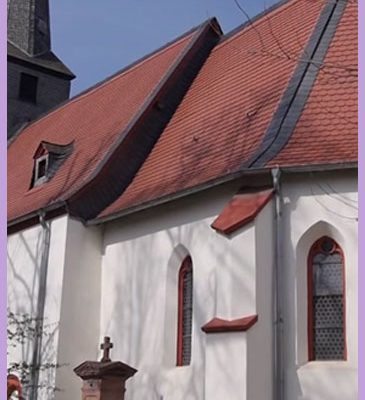
The protestant church of Weiterstadt: „A rediscovered gem“
In the 13th century there must have been a sacred building at the same place as todays church.
As a proof of that there is a bricked up rounded arch door beside todays side entrance on the south side of the church.
About 200 years later a little parish church was built there. Until today its choir and vestry are still preserved. In the pointed arch windows filled with gothic tracery the time of construction is written (end of 15th century).
In 1688 our church got its present day appearance, after the old nave had to be torn down. Thus today we have a single-nave church with side aisles fo equal height, choir and vestry. In the choir you find four of the just mentioned pointed arch windows. Furthermore a flat, barred niche on the right side, where we have our baptismal equipment and a little window case. Notable is as well the door to the vestry with its late gothic bonding.
A winding staircase goes up to the roofed renaissance pulpit, which is made of a six sided cube, standing on a cup-shaped pedestral. The walls are divided by round pointed niches with ornamental inlaid work.

In 1927 the first major renovation of the church happened. There the flat slab of the choir and nave got its present day paintings of floral ornaments. Furthermore wall paintings were revealed in the choir, which are dated back to the medieval construction phase. They were hidden underneath a thick layer of plaster. They are in a relatively good condition, showing the last days of Jesus Christ: The last supper, Jesus in Gethsemane, betrayal of Judas, bearing the cross, crucifixion, anointing of the corps by the women.
For the new construction of the church only local craftsmen were ordered and materials were mainly chosen from local areas (such as „oak wood“ form Mörtelnden, Büttelborn and „Danne Holtz“ (fir wood) from Gräfenhausen.
The exact date of inauguration of our church can be found as an inscription on the baptismal font. It was donated by a goldsmith form Darmstadt and is still in use today.
(extract of our church bulletin of Heinke Spangenberg 2003)






